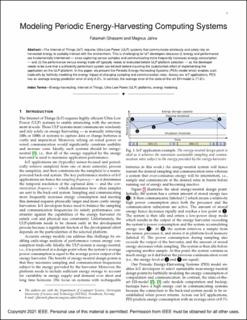| dc.contributor.author | Ghasemisoumeeh, Fatemeh | |
| dc.contributor.author | Jahre, Magnus | |
| dc.date.accessioned | 2021-11-03T12:40:57Z | |
| dc.date.available | 2021-11-03T12:40:57Z | |
| dc.date.created | 2021-10-26T09:39:45Z | |
| dc.date.issued | 2021 | |
| dc.identifier.issn | 1556-6056 | |
| dc.identifier.uri | https://hdl.handle.net/11250/2827604 | |
| dc.description.abstract | The Internet of Things (IoT) requires Ultra-Low Power (ULP) systems that communicate wirelessly and solely rely on harvested energy to scalably interact with the environment. This is challenging for IoT developers because (i) energy and performance are fundamentally intertwined — since capturing sensor samples and communicating more frequently increases energy consumption — and (ii) the performance versus energy trade-off typically needs to evaluated before ULP-platform selection — as the developer needs to be sure that a sufficiently performant system can be built before incurring the (substantial) effort of implementing the application on the ULP-platform. In this paper, we present the Periodic Energy-Harvesting Systems (PES) model which enables such trade-offs by faithfully modeling the energy impact of changing sampling and communication rates. Across our IoT applications, PES has an average energy prediction error of only 0.5%. In contrast, the average error of the state-of-the-art EH-model is 77.0%. | en_US |
| dc.language.iso | eng | en_US |
| dc.publisher | Institute of Electrical and Electronics Engineers (IEEE) | en_US |
| dc.title | Modeling Periodic Energy-Harvesting Computing Systems | en_US |
| dc.type | Peer reviewed | en_US |
| dc.type | Journal article | en_US |
| dc.description.version | acceptedVersion | en_US |
| dc.rights.holder | © IEEE. Personal use of this material is permitted. Permission from IEEE must be obtained for all other uses, in any current or future media, including reprinting/republishing this material for advertising or promotional purposes, creating new collective works, for resale or redistribution to servers or lists, or reuse of any copyrighted component of this work in other works. | en_US |
| dc.source.journal | IEEE computer architecture letters | en_US |
| dc.identifier.doi | 10.1109/LCA.2021.3117031 | |
| dc.identifier.cristin | 1948443 | |
| cristin.ispublished | true | |
| cristin.fulltext | postprint | |
| cristin.qualitycode | 1 | |
